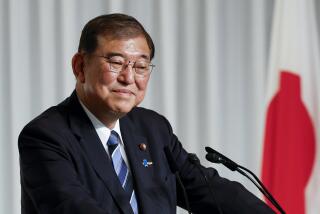Trying to Change the Immutable : Japan: The movement away from a closed, controlled society is a wake-up call for U.S. policymakers to adapt.
Much of the debate on U.S. policy in Asia makes an implicit and dangerous assumption about Japan. Because that country has remained so constant for so long, people expect that it will continue with the same goals and approach it has used for the last 50 years. But quite the contrary is true. There are demands from every quarter of society to rethink the nation’s most basic and long-standing practices and priorities. As this push for reform comes to dominate political debate, it will set new directions for Japan and require a parallel rethinking of U.S. policy.
Academics, business people, journalists, even labor leaders and some bureaucrats have joined the chorus for reform. They argue that Japan’s closed, controlled approach to economic organization has lost its effectiveness in an increasingly mature and diverse economy and because of the globalization of business and finance.
Odd that in a nation that has touted its approach as a superior alternative to Western capitalism, reform today means moving toward a more Western liberalization of markets and policy. In the words of Kenichi Ohmae, the management consultant turned politician and candidate for mayor of Tokyo: “No [government] policy can substitute for the efforts of individual managers in individual institutions to link their activities to the global economy.”
Some reformers even have attacked those sacrosanct elements of the system that had been presented as part of Japan’s ancient culture. Tokyo University economics professor, Yukio Noguchi, in his remarkable book, “The 1940 System,” argued that Japan’s well-established use of heavy regulation and centralized control was developed from whole cloth in 1940 as a part of the country’s growing war effort. Before 1940, Japan’s economic structure was quite like the capitalist systems of the West. By making this link to the despised wartime administration, Noguchi has done much in Japanese eyes to discredit the centralized approach, its practitioners and its defenders. That his book was well-received offers reason for optimism about Japan’s ability to function effectively under a different system.
Staking a position of moral leadership in this reform movement is Ichiro Ozawa, head of the main opposition New Frontier Party. His ideas and now those of his party found expression in his best-selling 1994 book, “Blueprint for a New Japan.”
Running very much contrary to the corporatist approach with which Japan has become linked, Ozawa starts from the premise that “real democracy begins with . . . the autonomy of the individual.” He and his party would shift Japan decidedly away from the closed, controlled approach of the past 50 years by breaking the power of the country’s immense bureaucracy, which Ozawa condemns for its lack of “accountability,” its self-serving interpretations of “ambiguous regulations” and its habit of imposing “advice.”
Ozawa’s program includes reform to simplify a tax code even more complex than the United States’ and opening of Japan to imports, other trade flows and foreign financial flows. He also would add the radical change of having Japanese diplomacy take a “more active and participatory stance in world affairs.” His party platform calls for Japan to secure a permanent seat on the U.N. Security Council and to take an active part in U.N. peacekeeping operations. Ozawa would go so far as to dispatch a portion of Japan’s self-defense troops as a permanent part of a proposed U.N. rapid deployment force.
The government, however, has offered few avenues by which Ozawa and other reformers could turn ideas into policy or even get an official hearing. There is hope, however, that the growing reform pressure and Ozawa’s leadership will force an end to this pattern of government drift and impotence, especially since they have a natural foil in Prime Minister Ryutaro Hashimoto. Unlike the equivocating politicians of recent years, Hashimoto and Ozawa are willing to confront each other and critical issues.
Despite Hashimoto’s adoption of the “rhetoric of reform,” there are significant differences between him and Ozawa. Unlike Ozawa, Hashimoto is very much in the long-standing Japanese political tradition. What specifics he has offered of his plans more or less support the status quo.
In the inevitable debate between these two strong men and their factions, Hashimoto’s side has an edge. His Liberal Democratic Party, though weakened, has a greater plurality in the parliament and a larger party machine. Even so, Hashimoto cannot proceed without making some concession to Ozawa, who has significant support. So Hashimoto will argue and yield where it is possible. He has already suggested breaking up the seemingly omnipotent Ministry of Finance.
For Japan, the new situation has to offer relief. Even though the kind of confrontation offered by Ozawa and Hashimoto is a departure from the culture’s preference for easy consensus, it begins at least to address issues that official Japan has neglected for too long. For the United States, no longer can policymakers, business people and investors assume a constant Japan with a single business or export objective.
More to Read
Sign up for Essential California
The most important California stories and recommendations in your inbox every morning.
You may occasionally receive promotional content from the Los Angeles Times.










